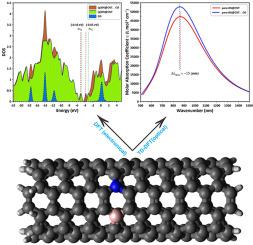Journal of Physics and Chemistry of Solids ( IF 4.3 ) Pub Date : 2021-06-23 , DOI: 10.1016/j.jpcs.2021.110230 Mahdi Abbasi , Ebrahim Nemati-Kande

|
Carbon nanotube (CNT) doped with boron (p-type) and nitrogen (n-type) atoms (BxNy@CNT) have attracted the attention of many experimental and theoretical researchers for variety of industrial applications such as catalytic processes in fuel cells and detection of environmental pollutants. BxNy@CNTs can be synthesized with different concentrations (i.e. x/y ratios) and various configurations (i.e. relative position of B to N atoms), and therefore, BxNy@CNTs show an unpredictable reactivity in physical and chemical reactions. Hence, the selection of an appropriate BxNy@CNTs combination to achieve the most efficiency for a specific application is a challenge for experimentalists. In this regard, herein, we investigated theoretically different combinations of BxNy@CNT (x, y = 0, 1), i.e. single doped boron (B@CNT) and nitrogen (N@CNT) along with multi-doped boron and nitrogen BN@CNT, in three ortho, meta and para-BN@CNT configurations for detection and removing of monoxide carbon (CO) as a diatomic toxic gas. Theoretical calculations were done based on the quantum calculations in DFT and TD-DFT levels of theory using M06-2X (and B3LYP-D3)/6-31+G(d,p) functional/basis set. We focused on variations in electrical (useable for electronic based nano-sensor devices) and optical (useable for optical based nano-sensor devices) properties after adsorption of CO gas. Results indicate that, compared to the other combinations, co-doping of boron in para position relative to nitrogen (para-BN@CNT) can significantly activate the inert-CNT toward CO sensing. Theoretical results of this work can help experimental scientists in the synthesis and selection of the appropriate BxNy@CNT combinations for applying in nanotube based nano-sensors.
中文翻译:

通过硼和氮杂原子的单掺杂和共掺杂提高碳纳米管检测一氧化碳的反应性:DFT 和 TD-DFT 研究
掺杂硼(p 型)和氮(n 型)原子 (B x N y @CNT) 的碳纳米管 (CNT)吸引了许多实验和理论研究人员的关注,用于各种工业应用,例如燃料中的催化过程细胞和环境污染物的检测。B x N y @CNTs 可以合成不同浓度(即x / y比)和各种配置(即 B 与 N 原子的相对位置),因此,B x N y @CNTs 在物理和化学方面表现出不可预测的反应性反应。因此,选择合适的 B x N y@CNTs 组合以实现特定应用的最高效率对实验者来说是一个挑战。在这方面,我们在这里研究了 B x N y @CNT ( x , y= 0, 1),即单掺杂硼(B@CNT)和氮(N@CNT)以及多掺杂硼和氮BN@CNT,在三种邻位、间位和对位BN@CNT配置中用于检测和去除一氧化碳 (CO) 作为双原子有毒气体。理论计算是基于 DFT 和 TD-DFT 理论水平的量子计算完成的,使用 M06-2X(和 B3LYP-D3)/6-31+G(d,p) 函数/基组。我们专注于吸附 CO 气体后电气(可用于基于电子的纳米传感器设备)和光学(可用于基于光学的纳米传感器设备)特性的变化。结果表明,与其他组合相比,在相对于氮的对位共掺杂硼 (para-BN@CNT) 可以显着激活惰性 CNT 对 CO 传感。x N y @CNT 组合用于基于纳米管的纳米传感器。











































 京公网安备 11010802027423号
京公网安备 11010802027423号